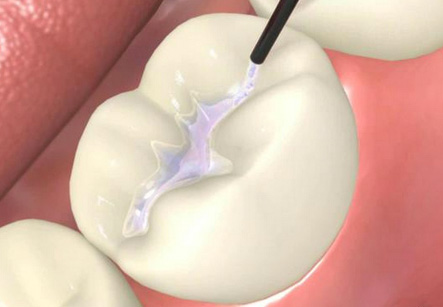Dental Sealant
Introduction
Dental sealants are coatings made of plastic that are usually placed on the chewing or occlusal surface of the permanent back teeth, such as the molars and premolars, for the purpose of protecting them from decay.
Purpose of placing dental sealants:
The chewing surfaces of the molar and premolar teeth are specialized as they have grooves or fissures. These grooves make them vulnerable to decay. Sometimes the fissures can be deep, may be difficult to clean, and can be narrower than even a single bristle of a toothbrush. Plaque tends to accumulate in these areas, and the acid produced by bacteria in the plaque attacks the enamel. This leads to formation of cavities. The dental sealants provide an additional protection for the grooved and pitted surfaces. The sealants provide a smooth surface covering over the fissured area. Dental sealants can be clear, white or have a slight tint depending upon the type of dental sealant used.
Decay damages teeth permanently. Sealants can save extra time, money, and the discomfort sometimes associated with dental fillings by preventing the decay. Also, the fillings are not permanent. At each time a tooth is filled, more drilling and removal of healthy tooth structure needs to be removed making the tooth a little weaker.
Iran offers a superior Dental treatments that is world best quality. For patients from the USA, and Europe for example, the savings can be 60% or more

Time of placement of dental sealants:
The first dental sealant is usually placed on the fissure of the first permanent molar tooth. This is done only after complete eruption of the chewing surface of the tooth beyond the gum. This tooth starts to grow in behind the baby teeth. If the chewing surfaces of these teeth are sealed, the dental sealant helps to protect the tooth. The molars and premolars continue to erupt until eleven-thirteen years of age and the chewing surfaces of these teeth can be sealed only after they have erupted completely beyond the gum. Only exception to this is wisdom tooth which starts to grow much later.
The reason for placing them on the chewing surfaces of these teeth is that they have typically deep fissures. Dental sealants are sometimes also used on other permanent teeth if they have grooves or pits. Sometimes when the molars in the primary dentition (baby teeth) also have grooves that need to be protected against decay, the dentist may recommend dental sealants on the chewing surfaces of these primary teeth.
In some adults who are at risk of caries, having deep grooves and fissures also can be benefitted by dental sealants. They can be useful if these teeth do not already have dentures.
Appearance of dental sealants:
Dental sealants can be clear, white or have a slight tint depending upon the type of dental sealant used. They can only be seen on a very close look. Sealant is not visible even while smiling, yawning or talking.
Procedure of dental sealant placement:
Placement of sealant does not require drilling or removal of tooth structure. The process of placement is short and very easy.
1. In first step, the tooth surface is thoroughly cleaned with the help of paste and rotating brush by the dentist. After this, the tooth is washed with cool water and dried.
2. An acidic solution is placed on the fissured area of the tooth’s chewing surface for a few seconds and rinsed off immediately. This creates fine microscopic areas and roughened surface more than the surrounding tooth enamel. This rough surface and microscopic areas help in attachment of the dental sealant to the tooth.
3. After drying of tooth, the liquid dental sealant is placed on the tooth. However, the dental sealant needs hardening. This is achieved by using a light beam or sometimes by using a two-component dental sealant that hardens without using a light.
4. As the dental sealant is hardened, it becomes a hard plastic varnish coating, and the patient can chew on the tooth without fear of being removed.
Longevity:
Dental sealants have been used and are proven to be effective since last 4 decades. Dental sealants can last for about 5 to 10 years without damage. The dental sealants should be checked at regular dental visits and a new sealant can be placed if it becomes necessary, in case of damage.
Use of fluoride after having a dental sealant:
Dental sealants only protect the surface area of the tooth covered by them. However, fluoride helps to protect all the surfaces of the tooth from decay and cavities.